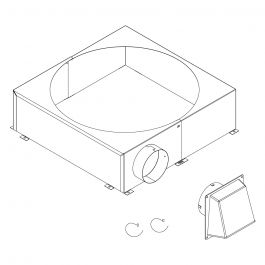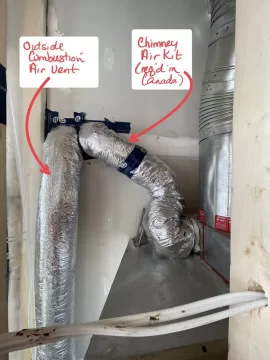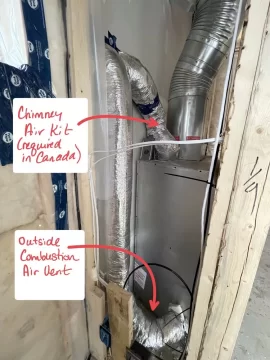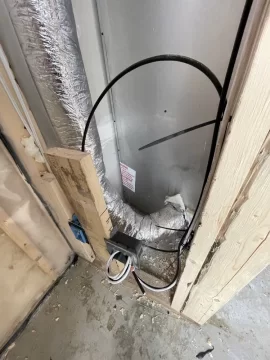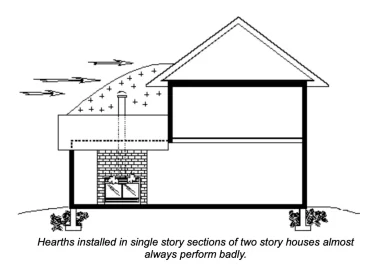Help, please! We have a new home with a detached (don't laugh) "She Shed," all completed in late 2022. The Shed has a wood-burning fireplace that billows smoke into the room within seconds after closing the window (as long as you leave it open, it's okay). I've attached photos of the actual fireplace, the exterior of the Shed, and the "floor plan/blueprint" of the Shed.
Here are some details about the "She Shed" and fireplace:
-Majestic Biltmore 42" (Model SB-80)
-The standard front opening dimensions are 28.5 tall x 42" wide (the height's now slightly reduced after we added a smoke shield, which didn't help.)
-The Shed has an ERV (no furnace - the Shed's heated with hydronic in-floor heat.)
-The square footage of the Shed is 434, with fewer bathrooms, so the two rooms (living & bar area) total around 390 sq. Ft.
-The chimney has a slight offset, and the chimney (started shorter) but has been extended to almost 19 feet tall (from the FLOOR of the Shed).
-The smoke billows in the same regardless if it's a cold winter night or a hot summer night.
We've had an HVAC company out where we've tried adding a fan to the exterior of the ERV intake to give the fresh air intake a "booster." We then tried adding that fan to the "Chimney Air Kit" & the "Outside Combustion Air Vent." We tried this with it blowing air into both at the same time and also into each vent separately. The only one that made a "slight" difference was when it was only blowing through the outside combustion air intake (which is the intake that leads to the cavity around the lower part of the fireplace). However, it still smoked within seconds of closing the window. Before these tests, the HVAC guys tested the air pressure with some device (he said he wasn't a fancy one). First, he said it seemed balanced; then, he said it was slightly negative. However, he said that adding the fan to boost the outside air coming in should've made it positive (but who knows).
Now, I'm not very familiar with fireplaces. Still, one thing I found odd was that even though this fan was blowing quite a bit of air through that Outside Combustion Air Intake, I couldn't feel any air around the fireplace openings. I'm unsure where that air goes and how it aids with the fire if you can't even feel it.
The company that installed it and everyone else trying to help are all scratching their heads. I'd be okay with leaving the window open, except that in our nasty winters, the window is right in the seating area. Hence, we need to wear a parka in this space because of the cold drafts that the open window brings with it. Not fun.
Any help would be GREATLY appreciated! Thanks kindly in advance.
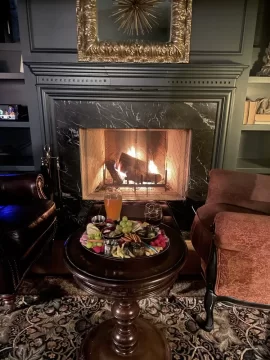
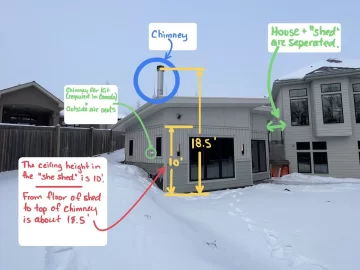
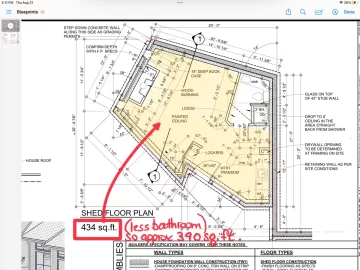
Here are some details about the "She Shed" and fireplace:
-Majestic Biltmore 42" (Model SB-80)
-The standard front opening dimensions are 28.5 tall x 42" wide (the height's now slightly reduced after we added a smoke shield, which didn't help.)
-The Shed has an ERV (no furnace - the Shed's heated with hydronic in-floor heat.)
-The square footage of the Shed is 434, with fewer bathrooms, so the two rooms (living & bar area) total around 390 sq. Ft.
-The chimney has a slight offset, and the chimney (started shorter) but has been extended to almost 19 feet tall (from the FLOOR of the Shed).
-The smoke billows in the same regardless if it's a cold winter night or a hot summer night.
We've had an HVAC company out where we've tried adding a fan to the exterior of the ERV intake to give the fresh air intake a "booster." We then tried adding that fan to the "Chimney Air Kit" & the "Outside Combustion Air Vent." We tried this with it blowing air into both at the same time and also into each vent separately. The only one that made a "slight" difference was when it was only blowing through the outside combustion air intake (which is the intake that leads to the cavity around the lower part of the fireplace). However, it still smoked within seconds of closing the window. Before these tests, the HVAC guys tested the air pressure with some device (he said he wasn't a fancy one). First, he said it seemed balanced; then, he said it was slightly negative. However, he said that adding the fan to boost the outside air coming in should've made it positive (but who knows).
Now, I'm not very familiar with fireplaces. Still, one thing I found odd was that even though this fan was blowing quite a bit of air through that Outside Combustion Air Intake, I couldn't feel any air around the fireplace openings. I'm unsure where that air goes and how it aids with the fire if you can't even feel it.
The company that installed it and everyone else trying to help are all scratching their heads. I'd be okay with leaving the window open, except that in our nasty winters, the window is right in the seating area. Hence, we need to wear a parka in this space because of the cold drafts that the open window brings with it. Not fun.
Any help would be GREATLY appreciated! Thanks kindly in advance.





